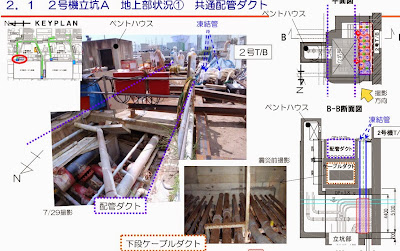All fuel assemblies - 1331 used and 202 new - in the Spent Fuel Pool of Reactor 4 at Fukushima I Nuclear Power Plant have been moved out of the pool. Most have gone to the Common Pool on the ground level. Some have been moved to the Spent Fuel Pool of Reactor 6, as they ran out of space in the Common Pool.
I suppose the purpose of the whole exercise was to placate those who were screaming "End of the world is near!" because "Reactor 4's building would collapse at any moment!" in various parts of the world (particularly North America). Condolences to workers who had to do the actual work and were exposed to large doses of gamma radiation that came from the operating floor of Reactor 3 right next, and from the Reactor 4 spent fuel pool itself due to the high level of cobalt-60 in the water in the Spent Fuel Pool; the water came from the DSP (device storage pool, where Reactor 4's core shroud had been stored temporarily) when the gate to the SFP was damaged in probably one of the aftershocks after the March 11, 2011 big earthquake and let the DSP water flood into the SFP. I wonder if TEPCO ever decontaminated the pool water.
---------------------------
Riken finally and very bluntly announced that the experiment to "recreate" STAP cells was a failure. Not even the 31-year-old Dr. (for now, till Waseda University, aka "PhD diploma mills" as many say now, revokes her degree) Haruko Obokata, who claims to have created the so-called STAP cells more than 200 times, couldn't do it, not even once. DNA analysis proved that Obokata's novel "STAP" cells were nothing but ES (embryonic stem) cells already known and widely used by reseachers.
Riken also concluded that there was NO EVIDENCE that Obokata had actually done the experiments that were reported in the Nature paper and letter. Everything, most likely, was made up. Outright fraud. I wonder if Harvard University is doing any investigation. After all, the Vacanti (of Vacanti-mouse fame) lab is where Obokata learned the trick.
Dr. Obokata released the statement saying she had "tried beyond my soul," whatever that means. Some accuse her of plagiarizing a famous sumo wrestler's words when he announced his retirement. (It seems to me that Obokata had confessed to her fraud when she said back in June this year that she wanted to be reunited with her "sons". Estranged Sons. ES.)
However, Riken very generously exonerated Obokata by saying they couldn't identify who "mixed in" ES cells more than 200 times.
From Riken's English summary of the detailed report (which is only available in Japanese, for experts and researchers):
It is unlikely that there was accidental contamination by three different ES cells, and it is suspected that the contamination may have occurred artificially. However, given the difficulty of identifying who might have contaminated the cultures, it is not possible to conclusively determine that it was artificial contamination. We cannot, therefore, conclude that there was research misconduct in this instance.
Obokata was allowed to quietly resign. It's good to be very well connected, I suppose, having Prime Minister and Minister of Education as fans.
----------------------------
The US and the West propaganda of Russia being the cause of all ills in the world notwithstanding, this one doesn't seem like being caused by Russia. There is a media report that the largest nuclear power plant in Ukraine and in Europe (and 5th largest in the world) may have a radioactive leak. The source of this news is RT, which has unfortunately not been that reliable when it comes to news about the Fukushima nuclear accident. RT quotes LifeNews that reports leaked official report.
From RT (12/31/2014):
A radioactive leak has been detected at Ukraine’s Zaporozhye Nuclear Power Plant, the largest in Europe, a media report says, citing the country’s emergency services. Ukrainian officials have denied the report.
LifeNews published what it claims is a leaked report by the State Emergency Service of Ukraine, which denies an earlier assessment by the plant’s authorities that the radiation at the facility is equal to the natural background following an incident on Sunday.
RT is trying to verify the report.
Ukrainian authorities have denied the Russian media report that a radioactive leak had taken place at the plant, Reuters reported.
"The plant works normally, there have been no accidents," an energy ministry official told the news agency. No official comment on whether the leaked documents are authentic has been provided.
Two documents released by LifeNews appear to show that the plant's officials put deliberately misleading information on their website. The documents – both addressed to the head of the regional emergency services – state that radiation levels at the plant on Sunday and Monday were 16.8 times higher than the legally permitted norm.
By Monday, the levels had slightly increased – growing from 16.3 to 16.8 times higher, and Unit 6 was still shut down, the report said, contradicting the plant's statements that the problem had been fixed and that the plant was operating normally.
(Full text at the link)
The article also says that the US Westinghouse (Toshiba) will "significantly increase fuel deliveries to Ukrainian nuclear power plants through 2020".
Good luck Ukrainians, if what Russia's Sputnik news agency has been tweeting is true.
From Sputnik (12/30/2014):
Nuclear energy experts and officials have repeatedly warned the Ukrainian authorities that it would be unsafe to use US-made fuel in reactors of Soviet and Russian design.
Happy New Year, everyone. I hope we will somehow survive and thrive in 2015, the year of sheep. (...)













































 Tokyo Time
Tokyo Time
![[Most Recent Quotes from www.kitco.com]](http://www.kitconet.com/charts/metals/gold/t24_au_en_usoz_2.gif)

